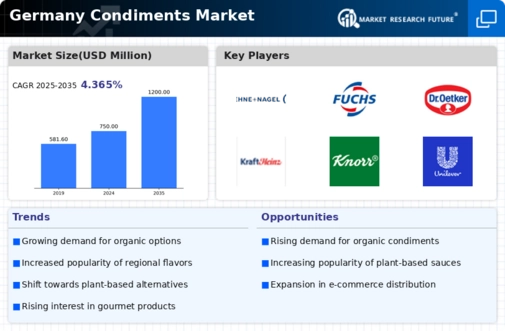Rising Demand for Organic Products
The condiments market in Germany is experiencing a notable shift towards organic products, driven by increasing consumer awareness regarding health and sustainability. As more individuals prioritize natural ingredients, the demand for organic condiments has surged. In 2025, organic condiments accounted for approximately 15% of the total market share, reflecting a growing trend among consumers who are willing to pay a premium for products that align with their health-conscious values. This shift is likely to continue, as consumers increasingly seek transparency in food sourcing and production methods. The condiments market is thus adapting to these preferences by expanding their organic product lines, which may further enhance market growth and consumer loyalty.
Convenience and Ready-to-Use Products
In the fast-paced lifestyle of modern consumers, convenience plays a crucial role in purchasing decisions within the condiments market. The demand for ready-to-use products, such as pre-mixed sauces and dressings, has been on the rise, as they offer time-saving solutions for meal preparation. In 2025, ready-to-use condiments represented nearly 40% of the total market, indicating a strong preference for products that simplify cooking processes. The condiments market is likely to continue focusing on convenience-oriented offerings, which may include single-serve packaging and easy-to-use formats, thus appealing to busy households and enhancing overall market growth.
Culinary Exploration and Global Flavors
The condiments market in Germany is significantly influenced by the growing interest in culinary exploration and the incorporation of global flavors into traditional dishes. As consumers become more adventurous in their eating habits, there is a rising demand for diverse condiments that offer unique taste experiences. This trend is reflected in the increasing popularity of international sauces and seasonings, which have seen a growth rate of around 10% in recent years. The condiments market is responding by innovating and introducing new products that cater to this evolving palate, thereby enhancing the overall market landscape and attracting a broader consumer base.
Influence of Social Media and Food Trends
The role of social media in shaping consumer preferences cannot be understated, particularly in the condiments market. Platforms such as Instagram and TikTok have become influential in promoting food trends, leading to increased visibility for unique and trendy condiments. In 2025, it is estimated that social media-driven trends contributed to a 20% increase in sales for certain condiment categories. The condiments market is likely to leverage these platforms for marketing strategies, engaging with consumers through visually appealing content and influencer partnerships. This dynamic interaction may foster brand awareness and drive sales, reflecting the evolving landscape of consumer engagement in the market.
Sustainability and Eco-Friendly Packaging
Sustainability has emerged as a pivotal driver in the condiments market, particularly in Germany, where consumers are increasingly concerned about environmental impact. The demand for eco-friendly packaging solutions is growing, as consumers prefer brands that demonstrate a commitment to sustainability. In 2025, approximately 25% of consumers indicated that they would choose condiments based on packaging sustainability. The condiments market is responding by investing in biodegradable and recyclable packaging materials, which not only meet consumer expectations but also align with broader environmental goals. This focus on sustainability may enhance brand loyalty and attract environmentally conscious consumers.





















Leave a Comment